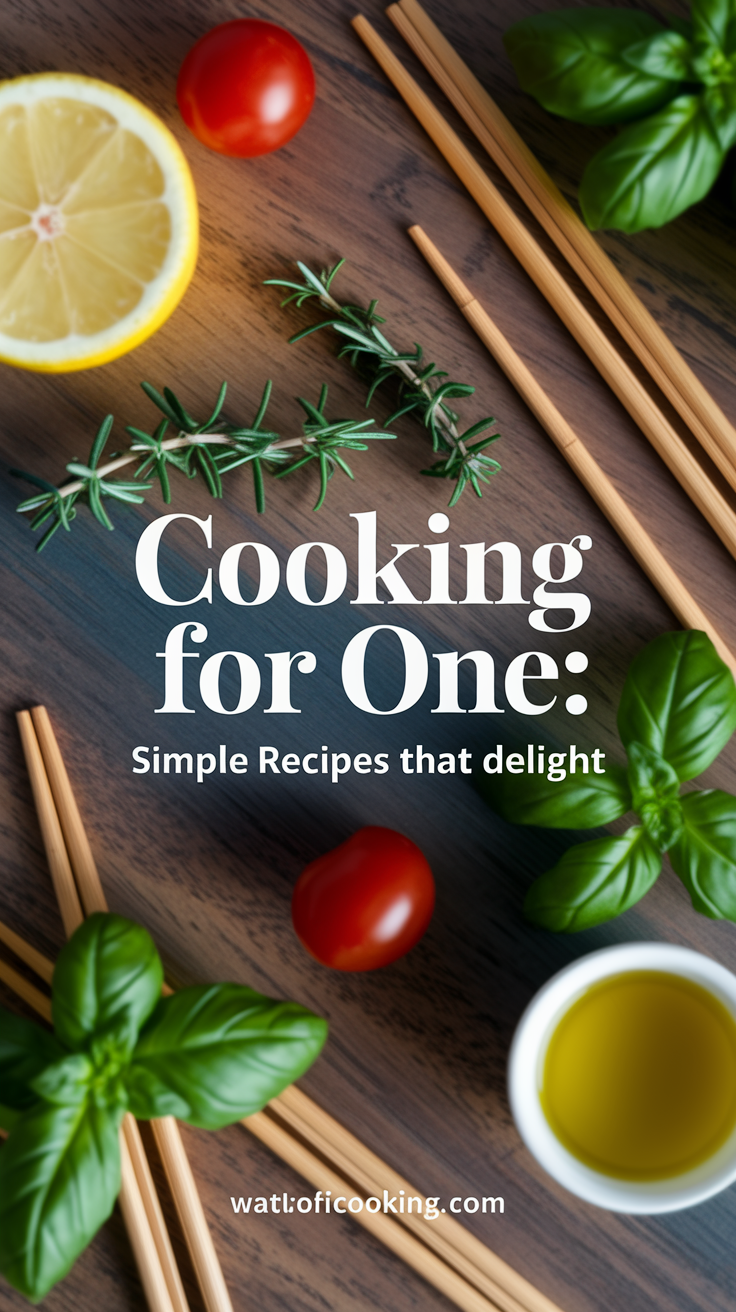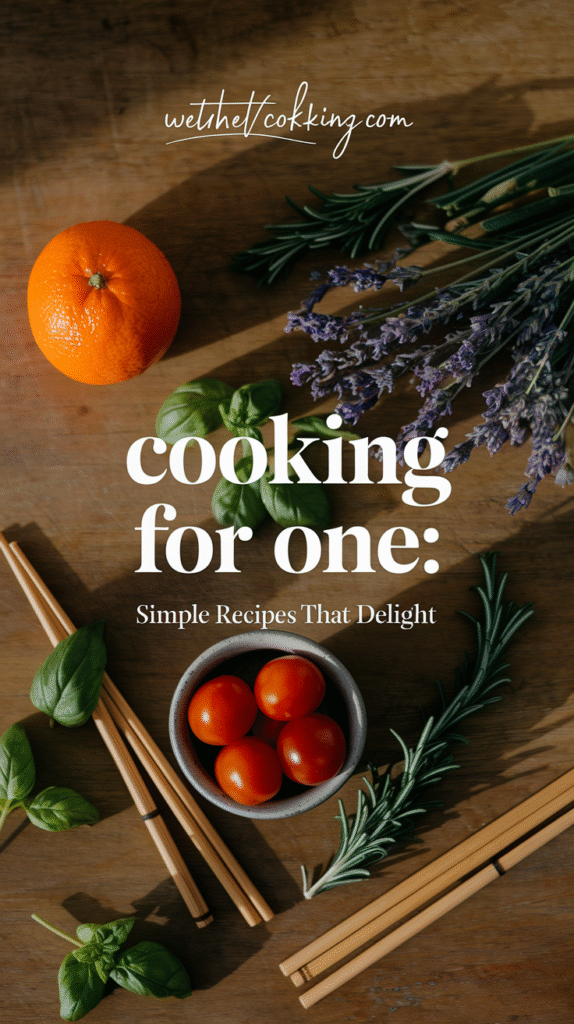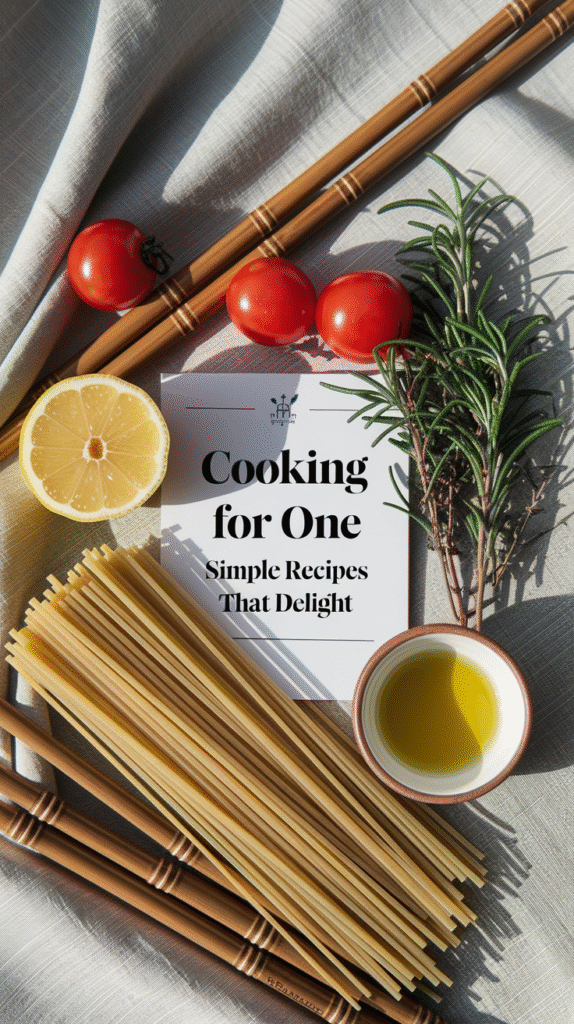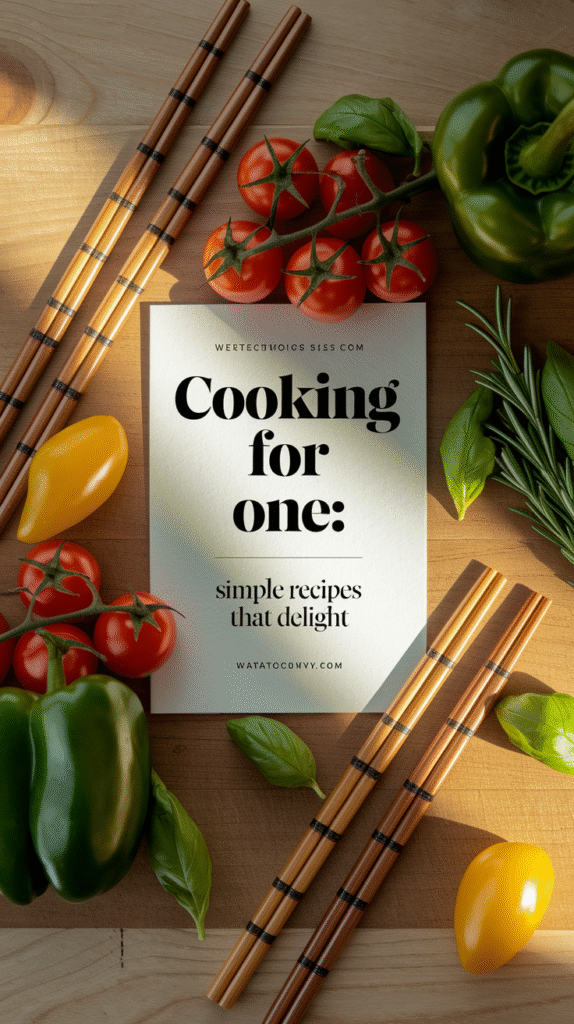Cooking for one can be a rewarding experience, helping you to create delightful dishes tailored to your tastes without large waste or excess. Whether you’re a busy professional, a student, or simply prefer dining solo, preparing meals for yourself can be both enjoyable and practical. Below are simple recipes to inspire your culinary journey.
Benefits of Cooking for One
When you cook for one, you have the freedom to explore flavors and cuisines without needing to cater to others’ preferences. Here are some key benefits:
- Creativity: You can experiment with ingredients and try new recipes that spark your interest.
- Portion Control: Cooking for one helps you manage portion sizes, contributing to a healthier diet.
- Cost-Effective: Shopping for yourself allows you to buy only what you need, minimizing food waste and saving money.
- Time-Saving: Preparing small meals can take less time, making it easier to fit cooking into your busy schedule.
Simple Recipes to Try
Here are four easy-to-make recipes that can satisfy your taste buds while keeping cooking simple and enjoyable.
1. Vegetable Stir-Fry
This dish is quick, packed with nutrients, and allows for flexibility based on what you have on hand.
Ingredients:
- 1 cup mixed vegetables (bell peppers, broccoli, carrots)
- 1 tablespoon soy sauce
- 1 teaspoon olive oil
- 1 clove garlic, minced
- 1/2 teaspoon sesame oil
- Cooked rice or noodles (optional)
Instructions:
- Heat olive oil in a pan over medium heat.
- Add garlic and stir-fry for 30 seconds.
- Add mixed vegetables and stir-fry for 5-7 minutes, until tender.
- Pour in the soy sauce and sesame oil, mixing well.
- Serve over cooked rice or noodles if desired.
2. One-Pan Chicken and Asparagus
This one-pan dish is perfect for busy evenings when you want minimal cleanup.
Ingredients:
- 1 chicken breast
- 1 cup asparagus, trimmed
- 1 tablespoon olive oil
- Salt and pepper to taste
- 1 lemon, sliced
Instructions:
- Preheat the oven to 400°F (200°C).
- Place the chicken and asparagus on a baking sheet.
- Drizzle with olive oil and season with salt and pepper.
- Top with lemon slices.
- Bake for 25-30 minutes or until the chicken is fully cooked.
3. Egg Fried Rice
A classic dish that can easily be adapted with whatever leftover ingredients you have.
Ingredients:
- 1 cup cooked rice
- 1 egg
- 1/4 cup frozen peas and carrots
- 1 tablespoon soy sauce
- 1 teaspoon sesame oil
Instructions:
- In a skillet, heat sesame oil over medium heat.
- Add peas and carrots, cooking for 2-3 minutes.
- Push the vegetables to the side and scramble an egg in the center.
- Once cooked, add the rice and soy sauce, mixing thoroughly.
4. Quick Tomato Soup
This comforting soup is perfect for chilly evenings and can be made with pantry staples.
Ingredients:
- 1 can diced tomatoes
- 1 cup vegetable broth
- 1/2 onion, chopped
- 1 clove garlic, minced
- Salt and pepper to taste
- Basil for garnish (optional)
Instructions:
- In a pot, sauté onion and garlic until translucent.
- Add the diced tomatoes and vegetable broth, then bring to a simmer.
- Season with salt and pepper. Purée if desired for a smooth texture.
- Garnish with fresh basil before serving.
Tips for Cooking for One
To make your cooking experience easier and more enjoyable, keep these tips in mind:
- Plan your meals weekly to reduce impulse cooking.
- Use leftover ingredients creatively to minimize waste.
- Invest in quality kitchen tools that simplify your cooking process.
- Consider batch cooking for staples that can be used in different meals.
Cooking for one doesn’t have to be a chore. With these simple recipes and tips, you can create delicious meals tailored to your preferences. Remember, the joy of cooking lies in the exploration of flavors and the comfort of enjoying your food. For more inspiring recipes, check out Food Network and BBC Good Food.
The Benefits of Meal Prepping for Solo Diners
Cooking for one can often feel like a daunting task, but meal prepping can transform it into a manageable and enjoyable experience. For solo diners, meal prepping not only saves time but also enhances the cooking experience. Let’s explore some of the top benefits of meal prepping specifically for those who dine alone.
Time Savings
One of the greatest advantages of meal prepping is the significant time savings it offers. Instead of cooking every day, you can dedicate just a couple of hours once a week to prepare several meals at once. This means you can spend less time in the kitchen and more time enjoying delicious food. Think about how much time you can reclaim:
- No daily cooking hassles.
- Reduced cleaning time after meals.
- Less stress during busy weekdays.
Cost-Effectiveness
Cooking for one can sometimes lead to wasted ingredients and higher grocery bills. Meal prepping allows you to plan your meals around sales and seasonal items, maximizing your budget. Here’s how you can save money:
- Buy in bulk: Purchase staples in larger quantities to avoid constant shopping trips.
- Use versatile ingredients: Choose foods that can be used across multiple meals.
- Reduce waste: Cook exact portions so that food does not go bad before you can eat it.
Healthier Choices
When you prepare meals in advance, you can prioritize healthy ingredients. This is a real game-changer for solo diners who might otherwise rely on convenience foods. Benefits include:
- Easy tracking of nutritional intake: Knowing what you eat helps you maintain a balance of macronutrients.
- Control over portions: You can ensure that each serving aligns with your dietary goals.
- Reduced temptation: When your meals are ready to go, you are less likely to reach for unhealthy snacks.
Variety and Creativity
Meal prepping allows you to experiment with new recipes and flavors without feeling overwhelmed. For solo cooks, trying out different cuisines can keep meals exciting and enjoyable. Here are some ways to bring variety to your meal prep:
- Theme your weeks: Try a different cuisine each week, like Italian, Mexican, or Asian.
- Incorporate seasonal produce: Utilize fruits and veggies that are in season for fresh flavors.
- Stay organized: Label your meal containers with dates and ingredients to mix and match easily.
You can also consider using tools like mealprep.com to find new recipes that suit your preferences.
Reduced Stress
Having meals ready to go can greatly decrease the daily stress of cooking. Whether you’ve had a long day at work or simply don’t feel like spending hours in the kitchen, meal prep is your ally. Here’s how it alleviates stress:
- No last-minute dinner decisions: With meals prepared, you don’t need to decide what to eat every evening.
- Fewer cooking mishaps: Having everything prepped minimizes the chance of overcooking or burning meals.
- Greater overall satisfaction: Knowing that healthy meals are on hand can improve your mood and energy levels.
Boosting Management Skills
Meal prepping not only helps with time and health management but also improves your organizational skills. Here are some considerations as you prepare your meals:
- Plan ahead: Create a comprehensive meal plan that outlines what to cook and when.
- Grocery lists are essential: Keep your shopping focused and efficient to avoid impulse buys.
- Learn food storage techniques: Understanding how to properly freeze and store food ensures it lasts longer.
Additionally, platforms such as prepd.com offer resources for meal prep planning and management.
By embracing meal prepping, solo diners can enjoy a mix of convenience, health, and creativity. The effort put into organizing meals pays off throughout the week, allowing you to savor each dish without the stress of daily cooking. With a little planning and creativity, you can turn cooking for one into an exciting culinary adventure.
Essential Kitchen Tools for Cooking for One
Cooking for one can be a rewarding experience, but having the right tools makes all the difference. When you’re preparing meals just for yourself, you want efficient, versatile, and easy-to-use kitchen tools. Below are essential items that will simplify your cooking journey.
Knife Set
A good knife set is fundamental for any kitchen, especially when cooking for one. A sharp chef’s knife, a paring knife, and a serrated knife will cover most food preparation tasks. Here are some key features to look for:
- Chef’s Knife: This multi-purpose knife is perfect for chopping, slicing, and dicing.
- Paring Knife: Ideal for peeling fruits and vegetables, as well as intricate cuts.
- Serrated Knife: Best for slicing bread and soft fruits.
Cutting Board
Choose a cutting board that is easy to clean and durable. A non-slip surface helps with safety, ensuring you have a stable platform while chopping. Consider using separate boards for meat and vegetables to avoid cross-contamination.
Small Cookware
When you’re cooking for one, smaller pots and pans are typically more practical. Invest in:
- One-Quart Saucepan: Perfect for cooking grains, sauces, or small portions of soup.
- Nonstick Skillet: Excellent for sautéing, frying eggs, or preparing quick meals.
- Small Baking Dish: Great for single servings of casseroles or baked dishes.
Measuring Tools
Accurate measurements can save you time and ingredients. A set of measuring cups and spoons specifically designed for small servings can be very helpful. Additionally, consider using a kitchen scale for precise measurements, particularly for baking.
Mixing Bowls
A few nesting mixing bowls can store and mix ingredients easily. Look for bowls that are lightweight and easy to handle. Materials like glass or stainless steel are both durable and versatile.
Food Storage Containers
Since cooking for one often means leftovers, having effective storage solutions is key. Choose airtight containers in various sizes to store your cooked meals or ingredients. Here’s a quick list of types to consider:
- Glass Containers: Ideal for reheating and usually dishwasher safe.
- Plastic Containers: Lightweight and economical for meal prep.
- Ziplock Bags: Excellent for storing smaller portions or marinating items.
Small Appliances
Some small kitchen appliances can significantly ease your cooking process:
- Microwave: Perfect for quick reheats or single-serve meals.
- Slow Cooker: Great for setting it and forgetting it. You can prepare a meal in the morning and come back to a delicious dinner.
- Blender: Useful for smoothies, soups, and sauces.
| Appliance | Function |
|---|---|
| Microwave | Quick reheating |
| Slow Cooker | Meal prep with minimal effort |
| Blender | Making smoothies and soups |
Utensils
Having the right utensils inspires confidence in your cooking. Stock up on a few essentials like:
- Spatulas: A silicone spatula is great for nonstick surfaces.
- Whisk: Ideal for mixing sauces and dressings.
- Ladle: Perfect for serving soups and stews.
Equipping your kitchen with these essential tools can make cooking for one easier, more efficient, and fun. For more advice on cooking for one, consider visiting Love and Lemons or Epicurious, where you can find recipes and tips tailored to solo diners. Enjoy your culinary journey!
Creative Leftover Ideas to Minimize Food Waste
Many of us are all too familiar with the scenario: you prepare a lovely meal, enjoy it, but then, you’re left with a fridge full of leftovers. Instead of letting these delicious morsels go to waste, consider some creative leftover ideas that not only minimize food waste but can also lead to new and exciting meals.
A New Approach to Leftovers
Leftovers don’t have to feel repetitive or mundane. By thinking creatively, you can breathe new life into yesterday’s meals. Here are some fun and easy ideas to transform your scraps into tasty entrees:
1. Leftover Vegetable Stir-Fry
Got leftover veggies? Toss them in a pan with some oil, soy sauce, and your favorite protein (like tofu or chicken). Stir-fry them up for a quick meal that’s both colorful and packed with nutrients.
2. Soups and Stews
Almost any leftover can be incorporated into a soup or stew. Combine your leftover meats, vegetables, and even grains into a broth for a hearty dish. Here’s a quick recipe:
- Start with a base of broth (chicken, vegetable, or beef).
- Add in any leftover proteins such as chicken or beef.
- Throw in vegetables like carrots, potatoes, or green beans.
- Season with herbs and spices to taste.
3. Creative Sandwiches
Transform leftover meats or roasted vegetables into delicious sandwiches. Pair them with some fresh greens and a tasty sauce or dressing. Here are some ideas:
- Shredded chicken with avocado and spinach on whole-grain bread.
- Grilled veggies with hummus on pita.
- Meatloaf slices in a roll with ketchup and pickles.
4. Casserole Creations
Casseroles are perfect for using up leftovers. Mix a layer of grains (like rice or pasta) with your leftover proteins and vegetables, cover with cheese, and bake until bubbly.
Boosting Breakfast with Leftovers
Don’t forget breakfast! Leftovers can easily be incorporated into morning meals. Consider these ideas:
1. Omelets and Frittatas
Mix leftover meats, beans, or vegetables into your egg mixture for a protein-packed breakfast. It’s quick, easy, and keeps the food from going to waste!
2. Smoothie Boosters
If you have overripe fruits, blend them into your morning smoothie. Throw in some leafy greens and yogurt for added nutrition and flavor.
Smart Storage Techniques
To ensure your food stays fresh and ready to be reincarnated, utilize smart storage techniques:
- Label containers with dates to keep track of freshness.
- Utilize airtight containers to prolong shelf-life.
- Spread leftovers flat in containers for even freezing and quick thawing.
Recipe Inspiration Resources
For creative recipes and additional tips on utilizing leftovers, check out these helpful resources:
- Food Waste Busters – Focused on reducing food waste with creative methods.
- Love Food Hate Waste – Offers recipes and tips to use up leftovers efficiently.
- Allrecipes – A broad platform to find recipes based on what you have.
Think Seasonally
Utilizing seasonal ingredients in your meals can also reduce waste. When you choose seasonal produce, it often lasts longer and tastes better. Plan your meals and snacks around these ingredients, ensuring you don’t buy more than you need.
Final Thoughts
Transforming leftovers into new meals is not only an eco-friendly practice but can also be a fun culinary adventure. With a little creativity and planning, you can turn food scraps into delightful dishes, ensuring that every bite counts. The next time you’re faced with leftovers, let these tips inspire you to minimize waste and maximize flavor!
Nutritional Tips for Balanced Meals When Cooking Solo
Eating alone can sometimes feel daunting, but it doesn’t have to be. Cooking for one means you can create balanced, nutritious meals that cater to your personal tastes and health needs without the extra hassle. Here are some nutritional tips to help you maintain a balanced diet while cooking solo.
Plan Your Meals
One of the first steps to eating well is meal planning. Set aside a little time each week to think about what you want to eat. This simple act can help you avoid last-minute unhealthy choices and streamline your grocery shopping.
- Choose Variety: Incorporate different vegetables, proteins, and grains into your meals. This not only enhances flavors but also ensures you get a broad spectrum of nutrients.
- Prep Ingredients: Consider chopping vegetables or pre-cooking grains in advance. This makes it easy to throw together a meal when you’re short on time.
Balance Your Plate
When plating your meals, aim for a balance of key food groups. A good rule of thumb is the “plate method.” Divide your plate into sections for:
| Food Group | Portion Size |
|---|---|
| Vegetables | Half of your plate |
| Protein | One quarter of your plate |
| Whole Grains | One quarter of your plate |
Utilizing this method ensures that you’re getting a mix of vitamins, minerals, and macronutrients. Don’t shy away from colorful vegetables like carrots, spinach, and bell peppers to make your meals visually appealing and nutritious.
Smart Shopping Tips
Keep your kitchen stocked with essential items that are versatile and have a long shelf life. This way, you can whip up meals without needing to run to the store every time. Here are some pantry staples to consider:
- Brown rice or quinoa
- Canned beans (like black or kidney beans)
- Frozen vegetables (great for soups and stir-fries)
- Olive oil or avocado oil for healthy cooking
- Herbs and spices to add flavor without added calories
Incorporate Lean Proteins
Proteins are crucial for muscle repair, immune function, and overall health. When cooking for one, opt for lean protein sources such as:
- Chicken breast or turkey
- Fish (such as salmon or tuna)
- Tofu or tempeh for plant-based options
- Eggs, which are versatile and nutrient-dense
Cooking larger portions at once can save you time too. For instance, grill extra chicken breasts to use in salads or sandwiches throughout the week.
Experiment with Healthy Fats
Healthy fats are not only delicious but also important for heart health and nutrient absorption. Consider incorporating:
- Avocado in your salads or toast
- Nuts and seeds as toppings for grains or yogurt
- Fatty fish such as salmon, which is rich in omega-3s
Remember to use oils like olive oil or coconut oil in moderation for cooking or dressings. They add flavor and health benefits without overwhelming your meal with calories.
Stay Hydrated
Don’t forget about hydration! Drinking plenty of water throughout the day is essential for digestion and overall health. Aim for at least 8 cups of water daily. If plain water feels boring, you can try:
- Herbal teas
- Infused water with fruits or herbs
- Low-calorie sparkling water
Cooking for one can be tricky, but with these nutritional tips, you can create balanced meals that are not only satisfying but support your health goals. For more information on meal planning and healthy eating habits, check out resources available on Eat Right and Choose My Plate.
By following these strategies, you’ll find cooking solo both enjoyable and rewarding, ensuring that you nourish your body with each bite.
Conclusion
Cooking for one doesn’t have to be a daunting or boring task. Embracing simple recipes can introduce a delightful variety to your meals while also saving time. Each dish you create allows for creativity and can be tailored to your personal taste. Meal prepping emerges as a game changer for solo diners, making weeknight meals easier and reducing the stress of daily cooking. By setting aside a little time each week, you can ensure healthy, home-cooked options are always at your fingertips.
Equipping yourself with the right kitchen tools can also enhance your cooking experience significantly. With essential gadgets, you can streamline your processes and turn your kitchen into a welcoming space for culinary exploration. Remember, cooking for one gives you the freedom to experiment without the pressure of catering to others.
Additionally, don’t let leftovers go to waste. With creative ideas and a bit of imagination, your remaining ingredients can transform into exciting new dishes. This not only saves money but contributes to a sustainable lifestyle. Prioritizing nutritional balance while cooking solo is key. A well-rounded diet is essential, and you can easily achieve this with mindful meal planning.
Making the most of your cooking experience while dining alone can lead to a healthier and more enjoyable lifestyle. By embracing these strategies, you empower yourself to savor each meal, cultivate your skills, and celebrate the joy of cooking for one. Happy cooking!







Leave a Reply